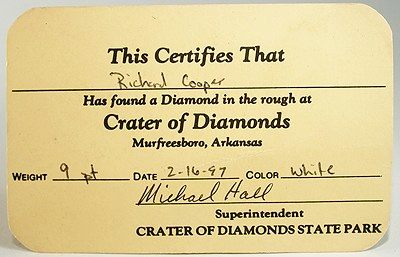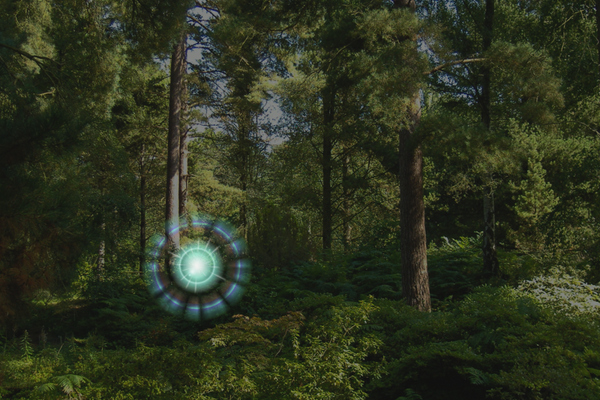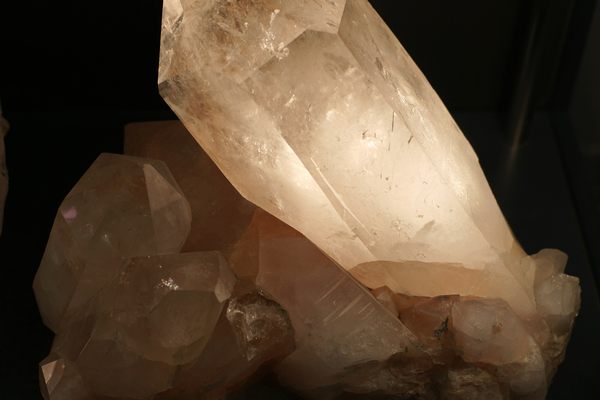Crater of Diamonds State Park
The only diamond mine in the world where you can keep what you find.
There are many versions of the tale, of how a man named John Wesley Huddleston became the first person to find diamonds in the soil of this jewel-rich crater near Murfreesboro, Arkansas, dubbing him the “Diamond King.”
The most well-known iteration of the story starts in 1906: Huddleston, an illiterate, middle-aged farmer, was working the soil of his turnip field on his 243-acre farm when he uncovered two strange, shiny yellow and clear stones. Not knowing what they were, Huddleston tested them on his grinding wheel, which he was told could shape anything but diamonds. As he worked the stones against the wheel, he saw that they left impressions in the wheel, and sent them off to be appraised by a jeweler in Little Rock.
Today, the site of his discovery, Crater of Diamonds State Park, is the only diamond mine in the world that’s open to the public, and you can keep what you find.
The park is the remnant of a series of dramatic geologic shifts and vicious volcanic activity dating back 3 billion years ago. High temperatures and pressures between 60 and 100 miles below the Earth’s crust crystallize carbon into diamonds. Then an explosion of gas and fragments during the formation of the volcanic vent known as the Prairie Creek diatreme brought these rocks and minerals up from deep in the earth.
The 83-acre funneled crater was left behind where the airborne material settled, preserving precious diamond stones in the soil. There the jewels remained for centuries, until Huddleston, lucky “Diamond John,” found the first stones.
Huddleston became nationally famous for his discovery. The two diamonds he found were appraised by the jeweler, who determined that the diamonds weighed 2-⅝ carats and 1-⅜ carats. Originally purchasing the land for $1,000 and a mule, Huddleston made a nice profit when he sold his farm for $36,000 to Little Rock investors who turned the area into a commercial diamond mining site. The news of the diamond mine brought many fortune seekers to Murfreesboro — reports and newspapers indicated that hotels in the area had to turn visitors away because they were overbooked.
Since Huddleston, hundreds of diamonds have been found in the crater. In 1999, officials reported the count at 471 of the precious stones. Many historical diamond discoveries have also come from the site: The 1.09-carat Strawn-Wagner diamond that received the highest, Triple Zero grade (a stone that has perfect symmetry, polish, and proportions), the 4.25-carat Kahn Canary diamond worn by Hillary Clinton during her husband’s presidential inaugural gala, and the 40.23-carat white Uncle Sam Diamond, the largest diamond ever found in the United States. Most recently, the park was the site where the 8.53-carat Esperanza diamond was found in June 2015. After it was cut into a 4.6-carat triolette shape, the Esperanza was valued at approximately $500,000.
The land has been handed over to many different owners until it was purchased by the state for $750,000 in 1972 and turned into the 911-acre Crater of Diamonds State Park. About 37 of those acres are open to the public to dig for diamonds.
On average, two diamonds are found per day at the park. It’s common to see children digging for diamonds and visitors sifting through the soil. But, there are a number of diamonds that go unaccounted for. Among the kids and tourists, there is a group of regular, local diamond hunters that don’t report their findings. They can be spotted digging deep holes and donning neoprene gloves and boots.
As for Huddleston, unfortunately, his luck quickly ran dry. He spent all of his money on bad investments and he died poor around 1936. Today, the farmer’s discovery is honored by the state park, which marked off the site where he found the crater’s very first diamond.
Know Before You Go
If the dirt in the search area is wet, you will need some old shoes or boots because the field will be very muddy. In the summer, a hat and sunscreen are recommended. Tools are not necessary for diamond seeking, and a good way to search is to walk up and down the rows looking for diamonds lying on top of the ground, but if you want to dig, you have the options of bringing your own tools from home, or you may buy buckets and trowels or rent buckets, shovels, screens, and other tools at the park.
At the Diamond Discovery Center, buy or rent tools and watch the instructional diamond mining video or one of the diamond searching demonstrations by a park interpreter for tips to improve your chances. Take the time to tour the exhibits, which demonstrate the appearance of diamonds in the rough and the three different search methods used at the park. If you find a diamond, they will certify it onsite. Tickets to search for diamonds are $10 for adults and $6 for children. Note: Dogs on leashes are allowed in most places in the park, including the mine area. Sun shelters and coolers stocked with non-alcoholic drinks are also allowed; however, battery-powered or motorized pieces of equipment (including flashlights and metal detectors) are not allowed in the mine area.
The park does have a café and a small water park, which are generally open seasonally between Memorial Day and Labor Day. Call the park or visit the park's website for exact dates. Call the park office for information on programs showing diamond-hunting methods.



































Follow us on Twitter to get the latest on the world's hidden wonders.
Like us on Facebook to get the latest on the world's hidden wonders.
Follow us on Twitter Like us on Facebook